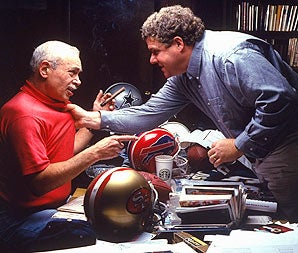The Doctor is in.
Paul Lionel Zimmerman was born on October 23, 1932, in Philadelphia, and grew up in The Bronx, where he went to Horace Mann School, one of New York City's elite prep schools. He went to Columbia University, where he played offensive line for the Lions' football team, and wrote for the school paper, the Columbia Daily Spectator. He said he had 2 literary idols: British journalist and novelist George Orwell (who famously described sport as "war minus the shooting") and sportswriter Jimmy Cannon.
He served in the U.S. Army in Germany during the Korean War, and played on a service team. As late as 1963, he was still playing minor-league pro football, for the Westchester Crusaders of the Atlantic Coast Football League. That league lasted from 1962 to 1973. The 1st 2 champions were based in New Jersey: The Paterson Miners and the Newark Bears.
He got a job writing for the New York Journal-American, and moved on to The World-Telegram & Sun. Both of those papers, the New York Herald-Tribune, and the New York Mirror were all mortally wounded by the 1962-63 New York newspaper strike. The Mirror published a farewell edition the day the strike ended, while the others hung on until 1966. Zimmerman was then hired by the New York Post, which, along with the Times and the Daily News, survives today (though it hasn't been easy for any of them).
He married Dr. Kate Hart, and had a daughter named Sarah and a son named Michael. He later married Linda Bailey, a woman he called "the Flaming Redhead" in his writings.
In 1970, he published The Thinking Man's Guide to Pro Football. Its opinions, based on his voluminous research, included one that a certain retired running back for the Cleveland Browns was the greatest player in the history of the sport. Not Jim Brown, as has often been said, but Marion Motley.
"Dr. Z" covered football for 3 newspapers in New York: The Journal-American, the World-Telegram & Sun, and the Post. In 1972, the Post sent him to Munich, Germany to cover the Olympics. He covered the Black September terrorism at the Games, watching as a journalist, an American and a Jew as the Palestinians murdered 11 members of the Israeli Olympic team. In 1979, he moved on to Sports Illustrated, and was their main pro football guy until felled by a stroke in 2008.
Dr. Z's writing on pro football, combining strong opinions with all kinds of facts to back them up, made him, along with Frank Deford, the magazine's most popular writer. This included a 1981 debate with college football writer John Underwood over which version of the game was better, a 1984 analysis of why quarterbacks weren't as good as they used to be (though the recent arrivals of Joe Montana and John Elway would prove him wrong), and a 1989 analysis of old game films to see if early stars like Bronko Nagurski and Don Hutson could make it in the current NFL -- and he agreed that some, including Nagurski, could. Those films also deepened his previous belief that Motley was still the best player in NFL history. (Motley, Hutson and Nagurski were all still alive at that point.)
In 1986, he was part of the ESPN team covering the NFL Draft. He was asked what "the NFL player of the 1990s" would be like. He said, "The player of the '90s will be so sophisticated that he'll be able to pass any steroid test they come up with." He never appeared on television again, not even in productions by NFL Films: Rather than air them in full, ESPN would edit out his statements in them. Alas, he turned out to be wrong about said sophistication: Even now, NFL players still get caught.
He made no pretense about being anything but old-school. He was the last writer at SI who was allowed to continue to use a typewriter to write his stories, with everyone else having moved on to computers. That 1989 game-film story featured a photo of Dr. Z, taken by the great SI cameraman Walter Iooss Jr., of him sitting next to an old-style film camera, with the light from it illuminating his voluminous cigar smoke. (I looked for that photo online. Sadly, I couldn't find it.)
In the early 1990s, he predicted 3 straight years that the Buffalo Bills would win the Super Bowl. All 3 times, they lost. The 4th time, even he couldn't kid himself anymore: He picked the Dallas Cowboys, and was right. But in 2008, he correctly predicted the biggest Super Bowl upset since the Jets over the Colts 39 years earlier: He said the Giants would beat the New England Patriots, and he did.
I also made that prediction. The only people who remember that now are my sister, her ex-boyfriend, and the couple we watched that Super Bowl with. And my sister is the only one of those I'm still on speaking terms with.
A few months after that Super Bowl XLII upset, Zimmerman suffered a stroke, incapacitating him to the point that his career as a writer was over. He remained a sound mind trapped in a nearly useless body. Last year, he published his last book, Dr. Z: The Lost Memoirs of an Irreverent Football Writer, with help from Peter King, his successor as SI's main NFL guy.
Dr. Z and King, in healthier times
Paul Zimmerman died this past Thursday, November 1, 2018, a few days after his 86th birthday. It's the end of an era. I hope it's not the end of a writing style, and I especially hope it's not an end to thinking people's viewing of sports. Pro football, in particular, could use it, perhaps more than ever.
UPDATE: His final resting place is not publicly known.



No comments:
Post a Comment